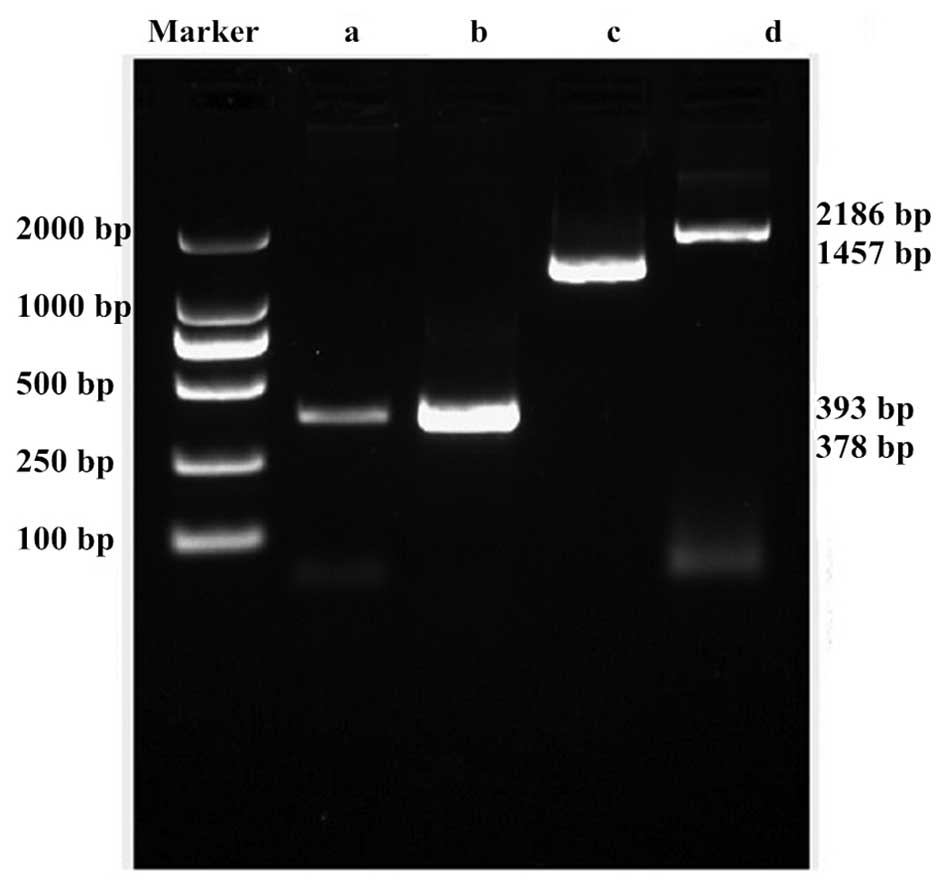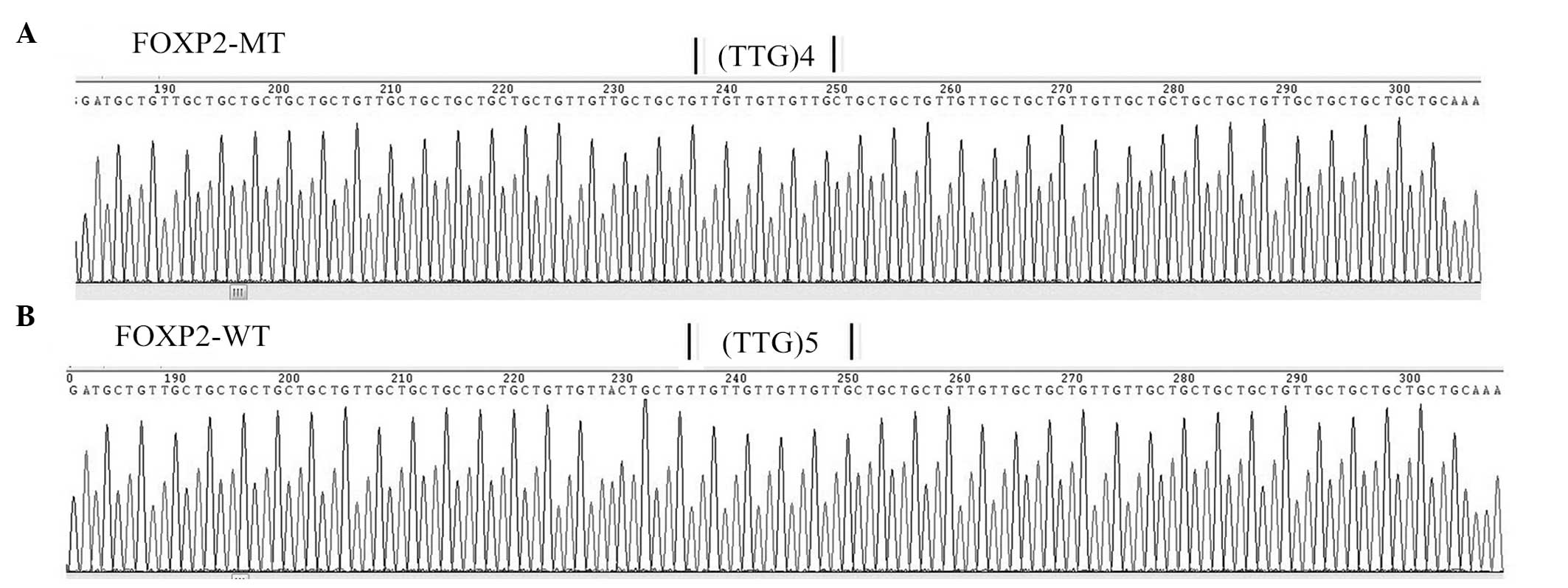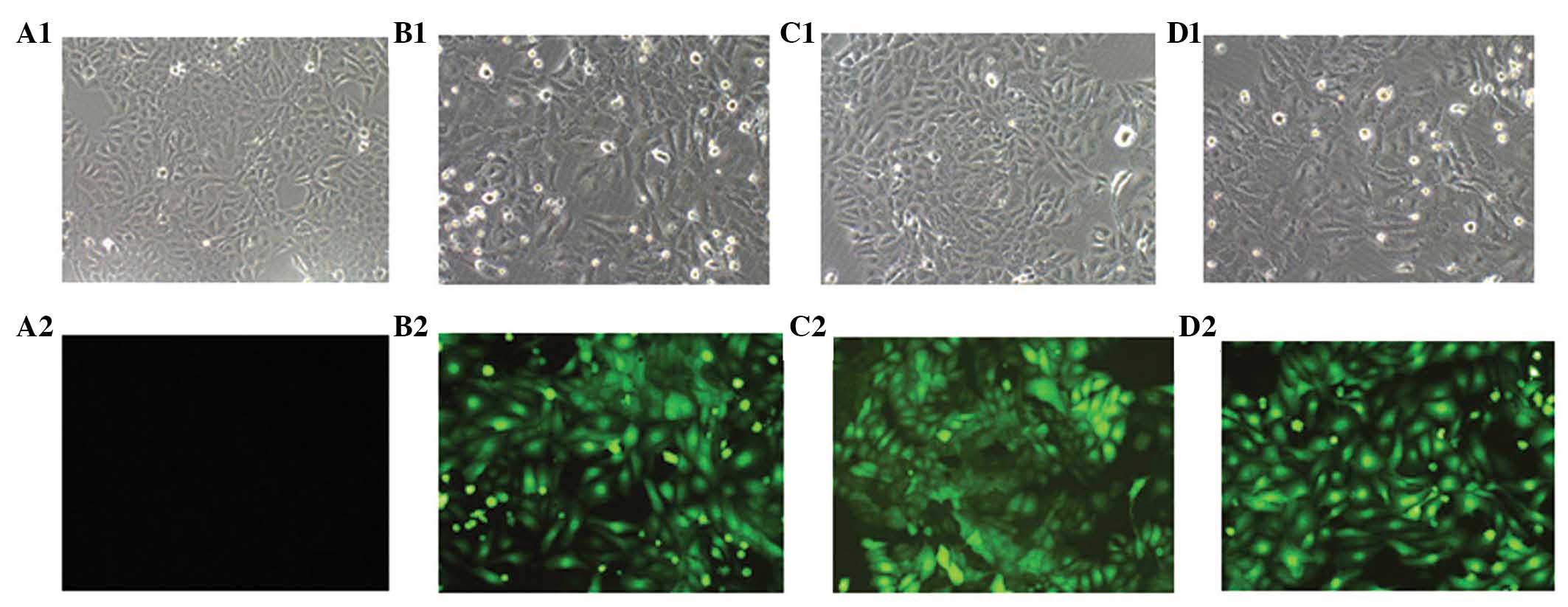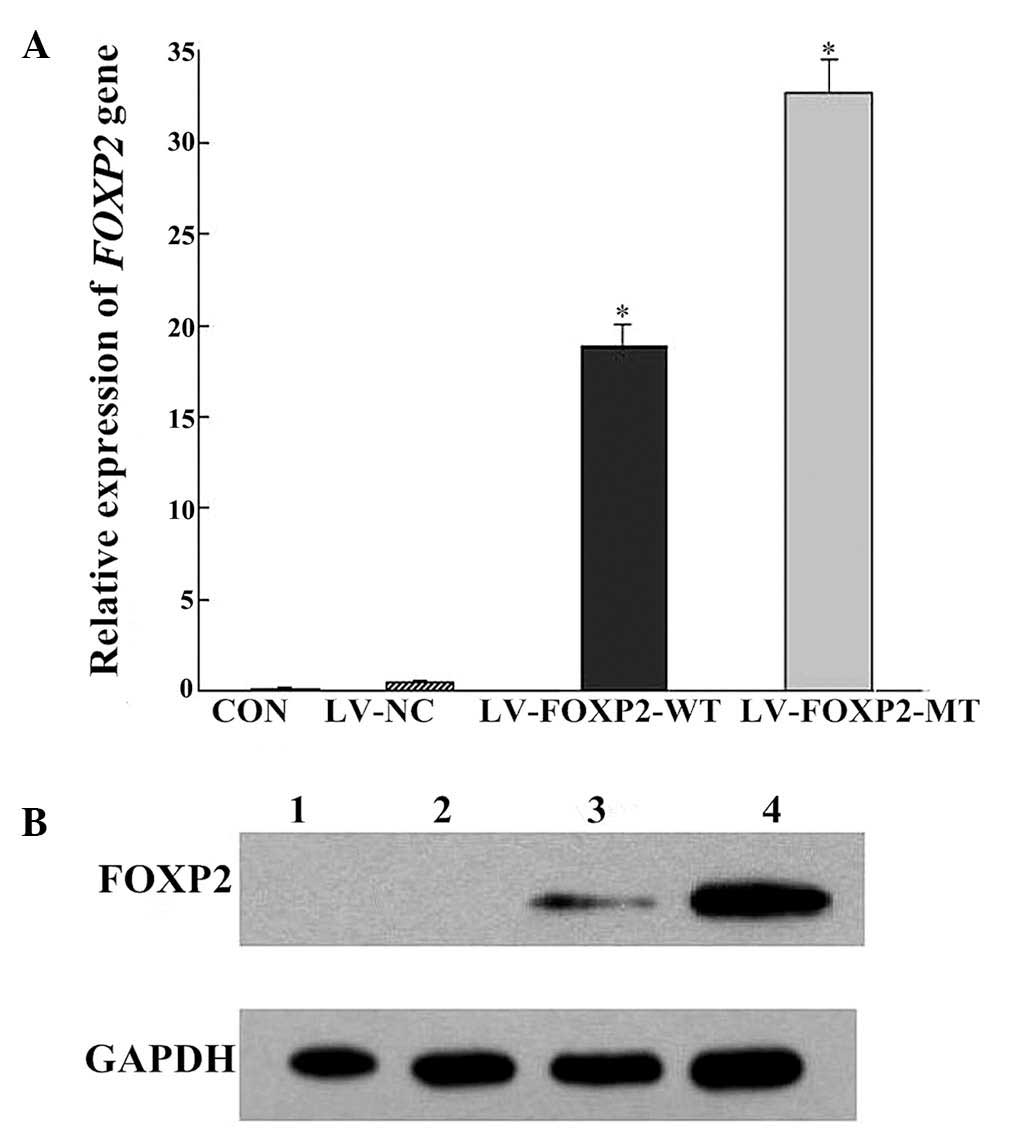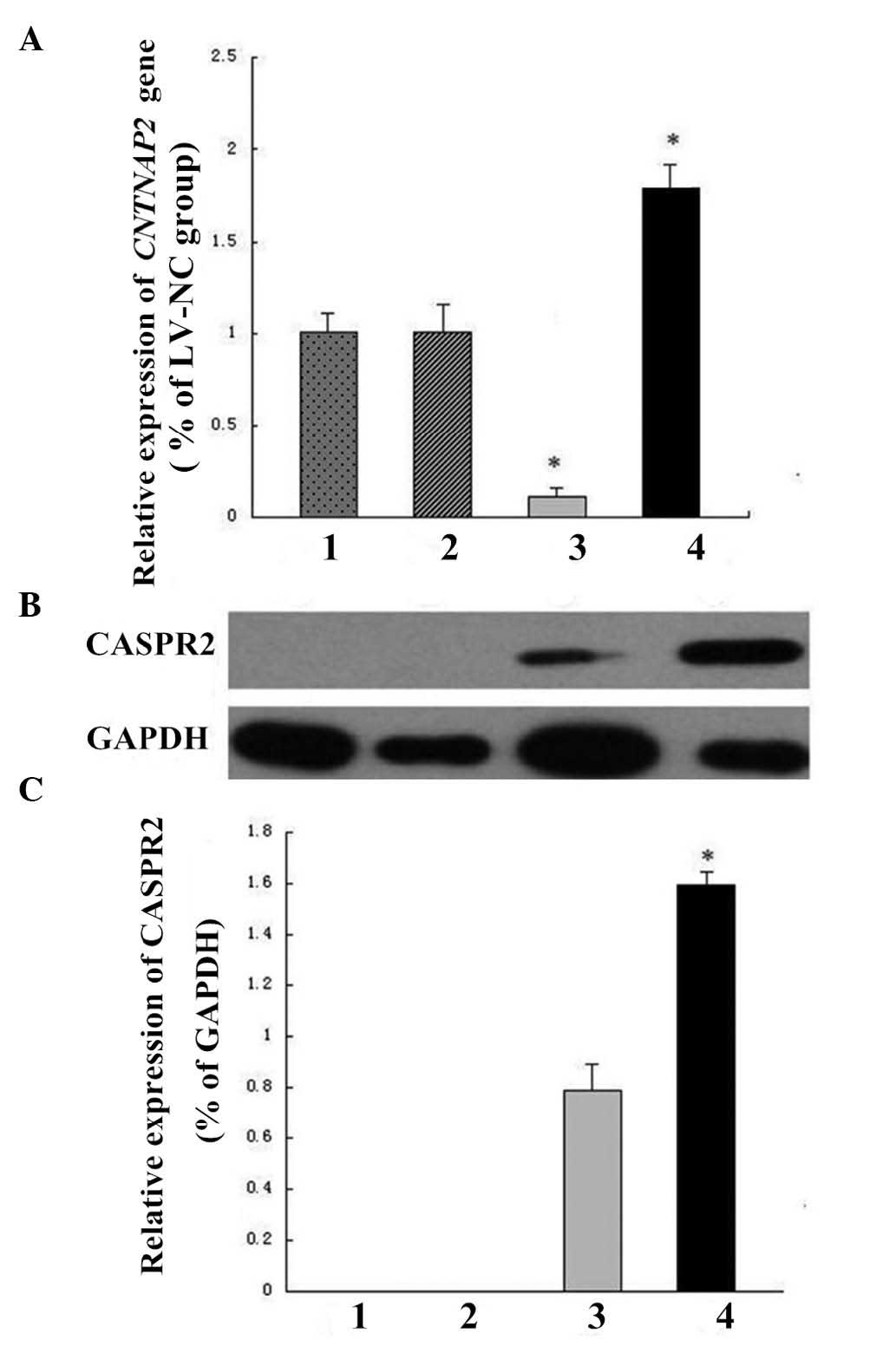|
1
|
Fisher SE, Lai CS and Monaco AP:
Deciphering the genetic basis of speech and language disorders.
Annu Rev Neurosci. 26:57–80. 2003. View Article : Google Scholar : PubMed/NCBI
|
|
2
|
Lai CS, Fisher SE, Hurst JA, Vargha-Khadem
F and Monaco AP: A forkhead-domain gene is mutated in a severe
speech and language disorder. Nature. 413:519–523. 2001. View Article : Google Scholar : PubMed/NCBI
|
|
3
|
MacDermot KD, Bonora E, Sykes N and Coupe
AM: Identification of FOXP2 truncation as a novel cause of
developmental speech and language deficits. Am J Hum Genet.
76:1074–1080. 2005. View
Article : Google Scholar : PubMed/NCBI
|
|
4
|
Shriberg LD, Ballard KJ, Tomblin JB, Duffy
JR, Odell KH and Williams CA: Speech, prosody, and voice
characteristics of a mother and daughter with a 7;13 translocation
affecting FOXP2. J Speech Lang Hear Res. 49:500–525. 2006.
View Article : Google Scholar : PubMed/NCBI
|
|
5
|
Feuk L, Kalervo A, Lipsanen-Nyman M, Skaug
J, Nakabayashi K, Finucane B, Hartung D, Innes M, Kerem B, Nowaczyk
MJ, et al: Absence of a paternally inherited FOXP2 gene in
developmental verbal dyspraxia. Am J Hum Genet. 79:965–972. 2006.
View Article : Google Scholar : PubMed/NCBI
|
|
6
|
Zeesman S, Nowaczyk MJ, Teshima I, Roberts
W, Cardy JO, Brian J, Senman L, Feuk L, Osborne LR and Scherer SW:
Speech and language impairment and oromotor dyspraxia due to
deletion of 7q31 that involves FOXP2. Am J Med Genet A.
140:509–514. 2006. View Article : Google Scholar : PubMed/NCBI
|
|
7
|
Lennon PA, Cooper ML, Peiffer DA,
Gunderson KL, Patel A, Peters S, Cheung SW and Bacino CA: Deletion
of 7q31.1 supports involvement of FOXP2 in language
impairment:clinical report and review. Am J Med Genet A. 143
A:791–798. 2007. View Article : Google Scholar
|
|
8
|
Zhao Y, Ma H, Wang Y, Gao H, Xi C, Hua T,
Zhao Y and Qiu G: Association between FOXP2 gene and speech sound
disorder in Chinese population. Psychiatry Clin Neurosci.
64:565–573. 2010. View Article : Google Scholar : PubMed/NCBI
|
|
9
|
Butland SL, Devon RS, Huang Y, Mead CL,
Meynert AM, Neal SJ, Lee SS, Wilkinson A, Yang GS, Yuen MM, et al:
CAG-encoded polyglutamine length polymorphism in the human genome.
BMC Genomics. 8:1262007. View Article : Google Scholar : PubMed/NCBI
|
|
10
|
Jodice C, Giovannone B, Calabresi V,
Bellocchi M, Terrenato L and Novelletto A: Population variation
analysis at nine loci containing expressed trinucleotide repeats.
Ann Hum Genet. 61:425–438. 1997. View Article : Google Scholar
|
|
11
|
Wren JD, Forgacs E, Fondon JW III,
Pertsemlidis A, Cheng SY, Gallardo T, Williams RS, Shovet RV, Minna
JD and Garner HR: Repeat polymorphisms within gene regions:
Phenotypic and evolutionary implications. Am J Hum Genet.
67:345–356. 2000. View
Article : Google Scholar : PubMed/NCBI
|
|
12
|
Mularoni L, Guigó R and Albà MM: Mutation
patterns of amino acid tandem repeats in the human proteome. Genome
Biol. 7:R332006. View Article : Google Scholar : PubMed/NCBI
|
|
13
|
Sobczak K and Krzyzosiak WJ: Patterns of
CAG repeat interruptions in SCA1 and SCA2 genes in relation to
repeat instability. Hum Mutat. 24:236–247. 2004. View Article : Google Scholar : PubMed/NCBI
|
|
14
|
MacDonald M: the Huntington's Disease
Collaborative Research Group: A novel gene containing a
trinucleotide repeat that is expanded and unstable on Huntington's
disease chromosomes. Cell. 72:971–983. 1993. View Article : Google Scholar
|
|
15
|
Vernes SC, Newbury DF, Abrahams BS,
Winchester L, Nicod J, Groszer M, Alarcón M, Oliver PL, Davies KE,
Geschwind DH, et al: A functional genetic link between distinct
developmental language disorders. N Engl J Med. 359:2337–2345.
2008. View Article : Google Scholar : PubMed/NCBI
|
|
16
|
Nakabayashi K and Scherer SW: The human
contactin-associated protein-like 2 gene (CNTNAP2) spans over 2 Mb
of DNA at chromosome 7q35. Genomics. 73:108–112. 2001. View Article : Google Scholar : PubMed/NCBI
|
|
17
|
Abrahams BS, Tentler D, Perederiy JV,
Oldham MC, Coppola G and Geschwind DH: Genome-wide analyses of
human perisylvian cerebral cortical patterning. Proc Natl Acad Sci
USA. 104:17849–17854. 2007. View Article : Google Scholar : PubMed/NCBI
|
|
18
|
Alarcón M, Abrahams BS, Stone JL, Duvall
JA, Perederiy JV, Bomar JM, Sebat J, Wigler M, Martin CL, Ledbetter
DH, et al: Linkage, association, and gene-expression analyses
identify CNTNAP2 as an autism-susceptibility gene. Am J Hum Genet.
82:150–159. 2008. View Article : Google Scholar : PubMed/NCBI
|
|
19
|
Arking DE, Cutler DJ, Brune CW, Teslovich
TM, West K, Ikeda M, Rea A, Guy M, Lin S, Cook EH Jr, et al: A
common genetic variant in the neurexin superfamily member CNTNAP2
increases familial risk of autism. Am J Hum Genet. 82:160–164.
2008. View Article : Google Scholar : PubMed/NCBI
|
|
20
|
Rossi E, Verri AP, Patricelli MG,
Destefani V, Ricca I, Vetro A, Ciccone R, Giorda R, Toniolo D,
Maraschio P and Zuffardi O: A 12Mb deletion at 7q33-q35 associated
with autism spectrum disorders and primary amenorrhea. Eur J Med
Genet. 51:631–638. 2008. View Article : Google Scholar : PubMed/NCBI
|
|
21
|
Bakkaloglu B, O'Roak BJ, Louvi A, Gupta
AR, Abelson JF, Morgan TM, Chawarska K, Klin A, Ercan-Sencicek AG,
Stillman AA, et al: Molecular cytogenetic analysis and resequencing
of contactin associated protein-like 2 in autism spectrum
disorders. Am J Hum Genet. 82:165–173. 2008. View Article : Google Scholar : PubMed/NCBI
|
|
22
|
Jackman C, Horn ND, Molleston JP and Sokol
DK: Gene associated with seizures, autism and hepatomegaly in an
Amish girl. Pediatr Neurol. 40:310–313. 2009. View Article : Google Scholar : PubMed/NCBI
|
|
23
|
Li X, Hu Z, He Y, Xiong Z, Long Z, Peng Y,
Bu F, Ling J, Xun G, Mo X, et al: Association analysis of CNTNAP2
polymorphisms with autism in the Chinese Han population. Psychiatr
Genet. 20:113–7. 2010.PubMed/NCBI
|
|
24
|
Whitehouse AJ, Bishop DV, Ang QW, Pennell
CE and Fisher SE: CNTNAP2 variants affect early language
development in the general population. Genes Brain Behav.
10:451–456. 2011. View Article : Google Scholar : PubMed/NCBI
|
|
25
|
Wassink TH, Piven J, Vieland VJ, Pietila
J, Goedken RJ, Folstein SE and Sheffield VC: Evaluation of FOXP2 as
an autism susceptibility gene. Am J Med Genet. 114:566–569. 2002.
View Article : Google Scholar : PubMed/NCBI
|
|
26
|
Konopka G, Bomar JM, Winden K, Coppola G,
Jonsson ZO, Gao F, Peng S, Preuss TM, Wohlschlegel JA and Geschwind
DH: Human-specific transcriptional regulation of CNS development
genes by FOXP2. Nature. 462:213–217. 2009. View Article : Google Scholar : PubMed/NCBI
|
|
27
|
Sobczak K and Krzyzosiak WJ: CAG repeats
containing CAA interruptions form branched hairpin structures in
spinocerebellar ataxia type 2 transcripts. J Biol Chem.
280:3898–3910. 2005. View Article : Google Scholar
|




